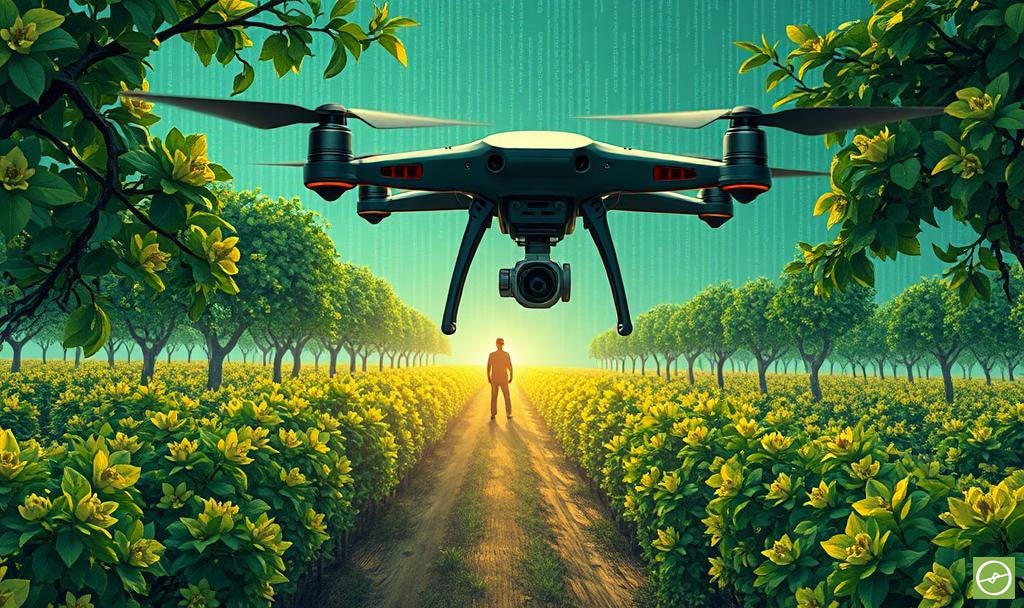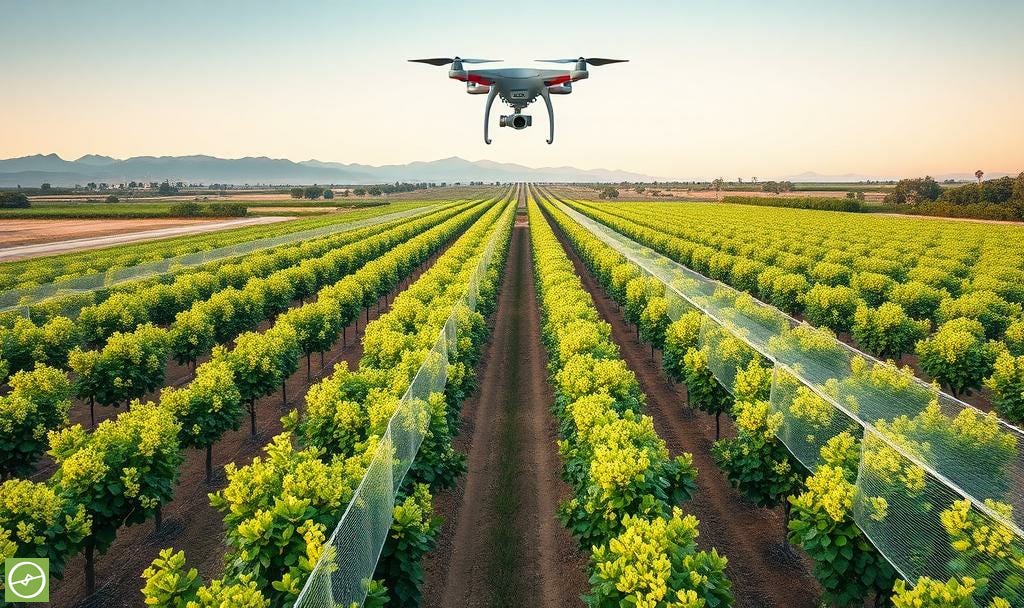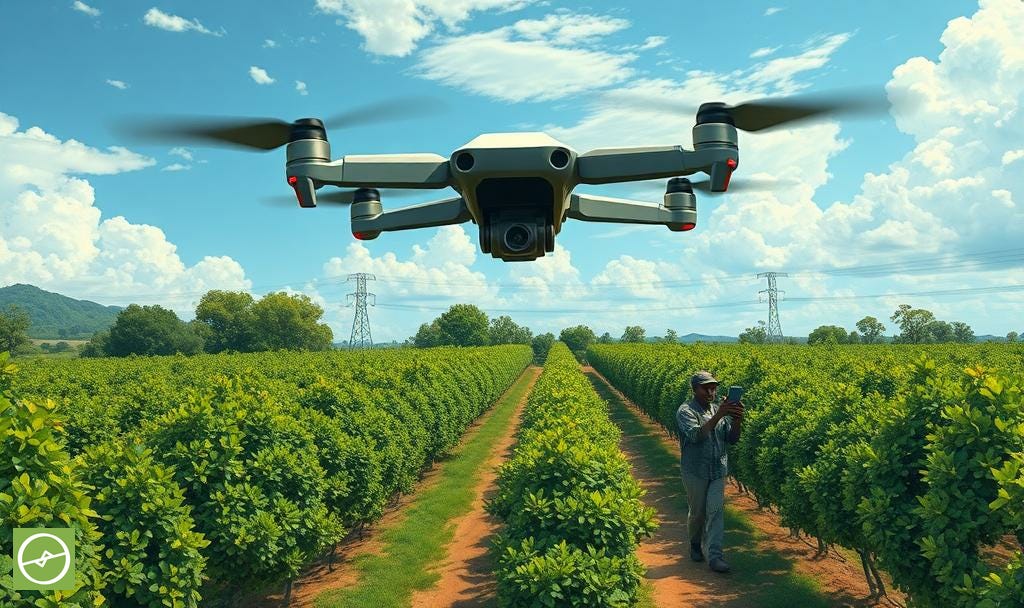Farmers, Wake Up: AI Won’t Wait While You Hesitate
How AI will decide the winners and losers in farming – and why resisting it could cost farming operations their orchards, their markets, and their future.
It’s 2029.
Orchards lie abandoned, fruit rotting on the ground.
Facilities box fruit and process nuts at half-capacity, because supplying orchards are not delivering the uniform high-quality produce the markets are demanding.
Export contracts seem to vanish overnight - rerouted to farming regions where AI-powered production leverages precision, yield clarity, and bolsters consistency.
The production teams who resisted a subtle yet powerful change are nowhere to be found. Competitors who worked smarter gained the upper hand, won contracts, and delighted their buyers, distributors, and consumers.
With newfound flexibility, real-time insights into yield, and increasingly efficient operations; AgTech systems give forward thinking farmers a clear competitive edge.
These tools not only streamline processes; they sharpen decision-making and open doors to markets that demand precision and traceability, along with quality.
Without systems that deliver flexibility, real-time yield insights, and efficient operations, farmers risk falling behind.
Competitors who embrace AgTech will scale faster, sell smarter, and capture the very contracts and margins that slower adopters will lose.
The divide is already widening.
And simply put: we cannot afford to wait or hesitate.
This is not science fiction. It’s the very real trajectory of agriculture if AI is to be ignored, misused, or dismissed as momentary hype.
We are part of a massive shift in value creation, operational protocols, and overall output for those who are able to make the best of the available tech, and that which is to come.
It’s nothing short of a transformative revolution. A global change in mindset and motion, akin to the birth of the renaissance, or the dawn of the industrial age.
Only this time it’s happening a whole lot faster.
Ladies and gentlemen… hold onto your hats!
Are you along for the ride?
“Competitors who embrace the right AgTech solutions will scale faster, sell smarter, and capture the margins you will lose due to your inaction.”
Not long ago, I wrote about how farmers could use online search to cut through the noise and find their “AgTech bestie” (find out more over here).
The principle was simple: go niche, focus on needs, and make sure integration is practical. That advice still stands.
But the battlefield has shifted.
Search engines are no longer the only tool at our disposal.
We are standing at the gates of the AI revolution, and some are already rushing past you while you stand gawking, jaw open wide.
Here’s the uncomfortable truth: farmers are caught between two futures - one where they use AI to thrive, and another where they risk being left behind in an industry they may shortly no longer recognise. Don’t wait until it’s too late.
Doers vs Directors in the Field
I want to be clear: AI doesn’t replace farmers.
It replaces wasted hours spent on menial tasks, and helps us to build reliability into key operational steps with automation, logic, and relevant systems protocols.
And it will highlight problems sooner than the naked eye ever would.
The real divide today is not between farmers who use technology and those who don’t. It is between doers and directors.
Doers stay busy - trapped in the day-to-day grind. They’re reactive.
Directors orchestrate. They choose what matters and delegate the rest - to people, to drones, systems, and AI. They’re proactive.
Drone data results that reveal hidden canopy stress and irrigation faults… or AI-driven fruit sizing tools that flag future pack-out problems…. These are not gimmicks. They are already available. They are the modern farmer’s competitive edge - powered by AI that’s only getting better and better. And the trajectory is not only non-linear it’s exponential.
The Farmer’s New Superpowers
If the internet has given farmers information, and social media has given them a voice, then AI now gives them three unprecedented powers:
Learning at speed: Compressing decades of research and knowledge into learnings paired with actionable insights within days.
Persuasion and communication: Shaping narratives, markets, and negotiations with clarity that once required teams of consultants, and big budgets.
Execution: Automating repetitive processing, time consuming analysis, and reporting so decision-making can be sharper, faster, and bolder.
These are not abstract concepts. They are the new currency of competitiveness.
Farmers who learn faster, communicate with impact, and execute at speed will shape the future of agriculture, and their very worlds. Those who hesitate will watch that future being written without them.
The question is: will you wield these new powers - or let them pass you by?
Taste, Trust, and the Signal-to-Noise Problem
The internet is now saturated with AI noise.
Sloppy text, mindless copy-paste, and meaningless reports. Flashy dashboards that do not connect to reality, and robotic “insights” with lifeless humdrum conclusions.
This is where taste matters. Farmers must learn to tell signal from noise. Those who filter wisely will act early, catch problems efficiently, and will tend to win markets. Those who don’t, will drown in half-baked AI outputs, chasing ghosts while drenched in meaningless spam; competitors surging ahead.
Learning to utilise AI is a large part of this journey in avoiding these misfortunes. And being able to distinguish signal from noise is a critical component we cannot afford to ignore.
Take Aerobotics’ TrueFruit solution as an example. It doesn’t replace scouts or managers. It replaces manual measurements, pen-and-paper, and wasted time. It filters hundreds of thousands of fruit measurements into clarity.
With AI the farmer’s role is neither diminished nor is it narrowed. It’s enhanced.
Utility vs Meaning: Where Humans Belong
AI can show you which orchard blocks are failing. But only you can decide whether to rip them out, rescue them, or double down for the next season.
Machines excel at utility - speed, repetition, and reliability, accuracy.
Humans thrive in meaning - story, judgement, context, and vision.
AI can show the size trajectory of your citrus crop. But only you can decide if your marketing strategy should pivot to early export or local retail - or a mix of the two.
AI can reveal, through weighted extrapolations of drone data and in-field nut count collections, which orchards are underperforming; and which blocks are falling below benchmark yields for their cultivar and tree age. But only you can decide whether to intervene, replant, or adjust strategies to bring those orchards back in line - or not.
Ignore this balance of man and machine, and you risk actually becoming the machine: mechanical, predictable, inflexible… and eventually replaceable. Irrelevant.
The Psychology of Adoption
Resistance to AI in farming is not really about technology. It’s about mental models that sabotage decision-making.
Loss aversion: The fear of losing control or tradition more than valuing the potential gains of utilising AI.
The sunk-cost-fallacy: Millions have been spent on current systems - so why change, even if they’re failing?
Status-quo bias: When “It’s what we’ve always done” feels safer than exploring, “What’s possible if we change how we do things?”
Opportunity cost blindness: Every year without AI is a year competitors pull ahead. The cost is initially invisible - until it’s too late.
These mental traps are the true enemy.
AI is not the villain. Our frame of mind is often the biggest baddy.
Preparing for the AI Future in Farming
So how do we as farmers prepare?
Become a philosopher-builder. Ask why, not just how. Use AI tools to serve a bigger vision of sustainability, profitability, or resilience.
Be a filter, not a sponge. Ruthlessly separate signal from noise. Don’t let AI outputs become your new clutter.
Orchestrate, don’t outsource. AI is the hired help. The director’s chair is still yours to fill.
Measure the opportunity cost. Ask yourself what it will cost you not to adopt high-end solutions that will move the needle in ways not previously possible.
The next 36-48 months will separate farmers into two camps: Those who will learn to direct AI and farm smarter, faster, and leaner. And those who don’t - who may wake up to find their orchards, their markets, and their legacy swallowed by those who did.
The choice is not whether AI belongs in the AgTech makeup of modern agriculture - it already does! The choice is whether you will lead with it, or be left behind by it.
Action Steps Summarised:
Adopt a director’s mindset: orchestrate, don’t just “do” or act blindly.
Audit your current workflows and identify tasks that can be automated by AI.
Train your “taste” - learn to spot useful AI outputs from meaningless noise.
Calculate the opportunity cost of not going forward with interventions. Because inaction is the most expensive action of all.
The thinking starts here, but the real change starts when you take action.
Why the Future of Farming Belongs to the Agile: The Adaptation Advantage
From macadamias to mandarins; the message is clear: Survival is no longer the benchmark. Adaptability is.
Per-tree Sampling Methods: Using AI for the Unfair Advantage
We can now use AI to generate sampling points (individual trees) based off the drone data metrics. Mostly used for crop and yield monitoring.
Macadamia Yield Forecasting: AI and Remote Sensing Strategies
In my mind, it's absolutely essential to explore current advancements in crop forecasting. A miscalculation can lead to supply chain disruptions, price fluctuations, and financial losses.







